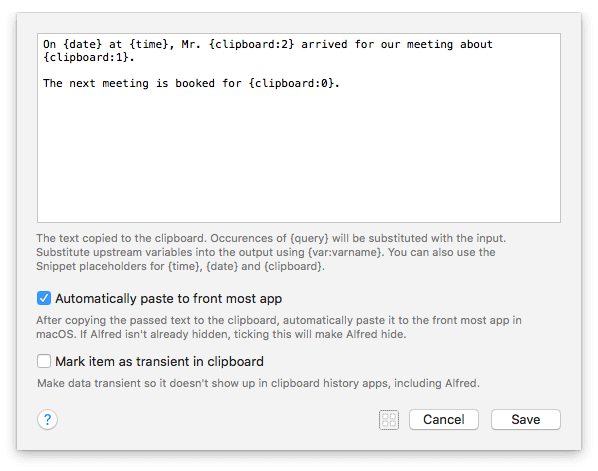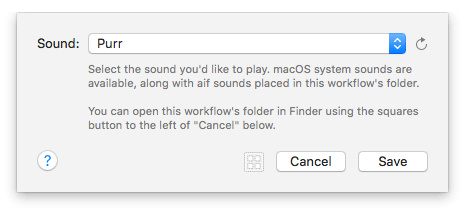Seven years ago, we released the very first build of Alfred - version 0.4 - while watching a Canada vs USA hockey game on TV, during the Vancouver Olympics. We watched with bated breath as friends, then strangers, shared the link far and wide, excited to discover Alfred. Before we knew it, we had our first 30,000 downloads!
Since 2010, Alfred has evolved so much, reaching millions of users, but has remained true to our original goal of being a slick, efficient productivity app to help you get more done on your Mac.
To mark Alfred's 7th birthday, we've set up a shop of Alfred-themed goodies; T-shirts, stickers, notebooks, phone cases, travel mugs and more, so that you can adorn your Mac (or yourself) with our iconic bowler hat!

Finally, we want to say thank you, whether you've been here since the first Alfred 0.4 beta or have recently joined in.
Want to celebrate with us? Take a moment to share your favourite Alfred tricks with friends or colleagues, and encourage them to grab the Powerpack to make the most of the fantastic Alfred 3 features.
We have an exciting year ahead, filled with amazing plans for Alfred; Be sure to stay in touch on Twitter or Facebook to be the first to hear about what we're up to!
Cheers,
Andrew & Vero
There are some releases that are particularly fun to test during the pre-release, and this was one of them; We've added a few brilliant features that will make fans of snippets and workflows very happy!
Accessing Clipboard History items from Workflows and Snippets
A big addition to this release is the new {clipboard:x} placeholder, which you can use to obtain items from Alfred's clipboard history. Add {clipboard:0} for the latest item, {clipboard:1} for the previous item, and so on.
There are so many practical uses for this feature;
- Create a snippet that dynamically includes the last three items you copied (e.g. an email address, a postal address and a URL)
- Add recently copied items as variables in your workflow
- Create a custom clipboard merge using the last two items you copied
Take a look at the new "Clipboard" workflow under the Getting Started built-in workflows to see the feature in action. We'll also be publishing a tutorial in the next few days to share a few of the ways we've already been using this feature.
You'll also find the date and time dynamic placeholders have been added to relevant utility and output workflow objects.

Better control over 1Password vaults
In November, we added access to multiple 1Password vaults, including Family and Team vaults, as well as secure notes and other non-login items.
In this release, we give you better control so that you can choose which vaults you want to see in Alfred, and whether non-login items should be included.
More ways to access Alfred's Preferences
While the quickest way to access Alfred's preferences is to pop up Alfred and use the cmd + , (cmd + comma) universal macOS shortcut for preferences, we've added another mouse-based way to get to them.
Right-clicking the bowler hat in the search bar will now show a menu with quick access to the preferences, the Update tab and a Quit option.

See all the ways you can access Alfred's preferences.
And much more...
In a continued effort to make Alfred as efficient and lightweight as possible, we've taken this opportunity to redraw many of the remaining bitmap icons to vector.
Not only do the icons now look much more modern in workflows, actions and the iTunes Mini Player, it's also had the effect of further reducing the download size, to around 2.8MB!
We've added a ton more optimisation, improvements and updated some web searches, so take a look at the change log to see the full list of new features, improvements and fixes included in this release.
It's already 14th December! How is this month flying by so fast?
While you look forward to a chance to put your feet up and chill out, have you taken a look at the Alfred Christmas Calendar?
In the calendar, we've shared daily tips and tricks, like setting up custom searches for your most-used sites and using file filters to make your file searches super efficient. We've also published a few festive themes, a free collection of fun sound effects for you to use on your Mac, and featured some of our favourite workflows.
And, well... We may have also photoshopped the Queen of England.
Of course, you'll need to take a look at the calendar to see for yourself. We also look forward to seeing your own creative bowler hat artistry over the next few days! ;)
We've been having so much fun adding the latest feature to Alfred; A new "Play Sound" workflow object. Of course, we had to create some sounds to tickle your ears with!
The Alfred Sound Bank Volume 1 contains 32 sounds created on the Make Noise 0-Coast, and is free to download from our Alfred Labs page - where you might just see other cool projects appear over the coming months! :D
The sounds are 24-bit, 44.1khz aif files, and are free to use under the Creative Commons Attribution-ShareAlike license. This means that you're free to use them in your Alfred workflows, your own apps or anywhere you like, with attribution.
Download the Alfred Sound Bank Volume 1.
How can I use the sounds in Alfred?
In Alfred 3.2.1, which we've just released today, we have added a new Output object to workflows called "Play Sound".
To add a sound to your workflow, add the "Play Sound" Output object to your workflow, and select a sound.
To add one of the new Sound Bank sounds, or your own, click the square button in the configuration and drop the aif or m4a file into this workflow folder. Press the "Refresh" arrow and choose your new sound from the Sound list.

Can I use the sounds in macOS too?
Absolutely! Add the sounds to ~/Library/Sounds/ and when you next launch your Sound System Preferences, you'll see these under the Sound Effects as "Custom", alongside the built-in ones provided by macOS.
If you then want to set one of these sounds for incoming mail in Mail.app for example, you'll launch Mail's General preferences and select the newly added sound for "New messages sound".
We look forward to seeing - and hearing - the latest auditory additions to your workflows. :)
Really, we should have called this release 3.3, as it's more than a simple bug-fix release, but Andrew couldn't resist a release number as entertaining as 3.2.1. (Hey, it's the small things in life!)
In today's release, we have added a new Output object to workflows called "Play Sound".
The File Action trigger now supports content type tree, so you can add +public.image as a file type for an action to show for all files conforming to this type. Easier than adding every image type manually to your filter!
We've also improved the snippet behaviour so that it behaves more predictably when using the {cursor} positioning, both in snippets and when using dynamic placeholders in the "Copy to Clipboard" object.
As usual, you can take a look at the complete change log for more details.





